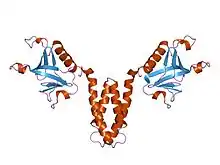Signal transducing adaptor protein
Signal transducing adaptor proteins (STAPs) are proteins that are accessory to main proteins in a signal transduction pathway.[1] Adaptor proteins contain a variety of protein-binding modules that link protein-binding partners together and facilitate the creation of larger signaling complexes. These proteins tend to lack any intrinsic enzymatic activity themselves,[2] instead mediating specific protein–protein interactions that drive the formation of protein complexes. Examples of adaptor proteins include MYD88,[3][4] Grb2 and SHC1.

Signaling components
Much of the specificity of signal transduction depends on the recruitment of several signalling components such as protein kinases and G-protein GTPases into short-lived active complexes in response to an activating signal such as a growth factor binding to its receptor.
Domains
Adaptor proteins usually contain several domains within their structure (e.g., Src homology 2 (SH2) and SH3 domains) that allow specific interactions with several other specific proteins. SH2 domains recognise specific amino acid sequences within proteins containing phosphotyrosine residues and SH3 domains recognise proline-rich sequences within specific peptide sequence contexts of proteins.
There are many other types of interaction domains found within adaptor and other signalling proteins that allow a rich diversity of specific and coordinated protein–protein interactions to occur within the cell during signal transduction.
Examples of adaptor proteins
Adaptor proteins include:
- BCAR3 – Breast cancer anti-estrogen resistance protein 3
- CBL – Casitas B-lineage Lymphoma
- FRS2 – Fibroblast growth factor receptor substrate 2
- GAB2 – GRB2-associated binding protein 2
- GRAP – GRB2-related adaptor protein
- GRAP2 – GRB2-related adaptor protein 2
- GRB2 – Growth factor receptor-bound protein 2
- IRS1 – Insulin receptor substrate 1
- LDLRAP1 – low-density lipoprotein receptor adaptor protein 1
- MYD88 - Myeloid differentiation primary response gene 88
- NCDN - Neurochondrin
- NCK1 – NCK adaptor protein 1
- NCK2 – NCK adaptor protein 2
- NOS1AP – nitric oxide synthase 1 (neuronal) adaptor protein
- PIK3AP1 – phosphoinositide-3-kinase adaptor protein 1
- SH2B1 – SH2B adaptor protein 1
- SH2B2 – SH2B adaptor protein 2
- SH2B3 – SH2B adaptor protein 3
- SH2D3A -SH2 domain containing 3A
- SH2D3C – SH2 domain containing 3C
- SNTA1 – Syntrophin, alpha 1
- SHB – Src homology 2 domain containing adaptor protein B
- SLC4A1AP – solute carrier family 4 (anion exchanger), member 1, adaptor protein
See also
- Wikipedia:MeSH D12.776#MeSH D12.776.157.057 --- adaptor proteins.2C signal transducing
- Wikipedia:MeSH D12.776#MeSH D12.776.543.990.150 --- adaptor proteins.2C vesicular transport
References
- "Role of Signal Transducing Adaptor Protein (STAP) Family in Chronic Myelogenous Leukemia". Retrieved 24 August 2018.
- Signal+Transducing+Adaptor+Proteins at the U.S. National Library of Medicine Medical Subject Headings (MeSH)
- "Entrez Gene: MYD88 Myeloid differentiation primary response gene (88)".
- Bonnert TP, Garka KE, Parnet P, Sonoda G, Testa JR, Sims JE (January 1997). "The cloning and characterization of human MyD88: a member of an IL-1 receptor related family". FEBS Letters. 402 (1): 81–4. doi:10.1016/S0014-5793(96)01506-2. PMID 9013863. S2CID 44843127.
Further reading
- TAB2 is an adaptor protein involved in the IL-1 signal transduction pathway: Takaesu G, Kishida S, Hiyama A, Yamaguchi K, Shibuya H, Irie K, Ninomiya-Tsuji J, Matsumoto K (April 2000). "TAB2, a novel adaptor protein, mediates activation of TAK1 MAPKKK by linking TAK1 to TRAF6 in the IL-1 signal transduction pathway". Molecular Cell. 5 (4): 649–58. doi:10.1016/S1097-2765(00)80244-0. PMID 10882101.
- Good article about adaptor proteins involved in protein kinase C-mediated signal transduction: Schechtman D, Mochly-Rosen D (October 2001). "Adaptor proteins in protein kinase C-mediated signal transduction". Oncogene. 20 (44): 6339–47. doi:10.1038/sj.onc.1204778. PMID 11607837.
- A good article regarding the role of adaptor proteins involved with the T-cell antigen receptor: Samelson LE (2002). "Signal transduction mediated by the T cell antigen receptor: the role of adapter proteins". Annual Review of Immunology. 20 (1): 371–94. doi:10.1146/annurev.immunol.20.092601.111357. PMID 11861607.
- Signalling discussed with regards to adaptor proteins: Pawson, T. (1997). "Signaling Through Scaffold, Anchoring, and Adaptor Proteins". Science. 278 (5346): 2075–2080. Bibcode:1997Sci...278.2075P. doi:10.1126/science.278.5346.2075. ISSN 0036-8075. PMID 9405336.